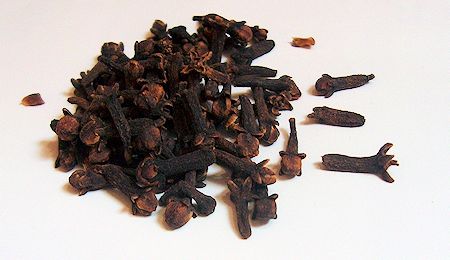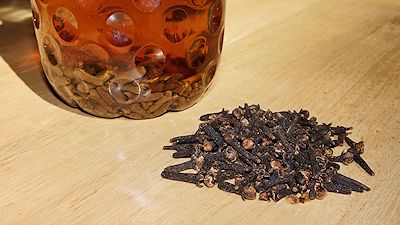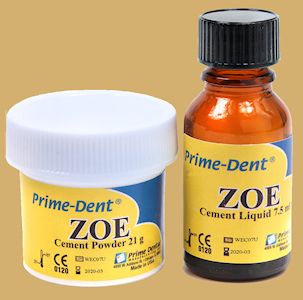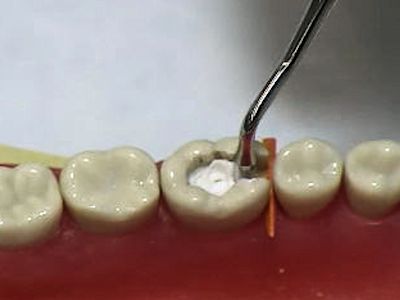![]()
Eugenol
The smell of cloves and a
potential treatment for 'brain-freeze'.
![]()
![]()
Molecule of the Month January 2022
Also available: HTML version.
![]()

Some cloves
EugenolThe smell of cloves and a
|
 Some cloves |
Eugene-ol - that’s nothing to do with the engineer from The Walking Dead, is it?No, you're thinking of Eugene Porter, and this molecule has nothing to do with him. Then how did it get its name?From Eugenia caryophyllata, the old Latin name for cloves. In fact, eugenol is the main ingredient (70% to 85%) in Oil of Cloves. What’s that?It’s an oil that’s used in aromatherapy and some perfumes, and as a flavour agent in food and medicines. But its most well-known use is as a ‘natural’ painkiller for toothache. |
 Eugene Porter (played by actor Josh McDermitt) from The Walking Dead. |
 |
 |
|
| Cloves and a bottle of Oil of Cloves. [Photo: epSos.de, CC BY 2.0 via Wikimedia Commons] |
Eugenol |
Yes, clove oil has been used in traditional Indian and Chinese medicine for centuries to relieve tooth pain. In the early 1800s, chemists discovered that its main ingredient was eugenol, and it was believed to act as an anaesthetic, as well as have antibacterial anti-inflammatory and antifungal properties. In 1837, eugenol and magnesium oxide were combined to create a dental filling material. Soon after, the magnesium oxide was replaced by zinc oxide to create zinc oxide eugenol (ZOE), which is still widely used as a temporary tooth filling cement in some countries.
 |
 |
| A ZOE cement for filling teeth cavities. | Temporarily filling a tooth cavity with ZOE cement. The powder is mainly zinc oxide and the liquid is eugenol with olive oil as a plasticiser. |
There is also a folk remedy for toothache in many other countries that involves applying Oil of Cloves, usually via a cotton swap, to the gum near the affected tooth. There are also reports of people placing whole cloves on the gums as well! In fact, since the 19th century, many dentists have used eugenol in root canal therapy, periodontal therapy, and to treat abscesses.
Although there is quite a bit of anecdotal evidence, until recently there were very few properly conducted scientific studies on the effectiveness of eugenol. As a result, in 2020 the US Federal Drugs Administration (FDA) stated that there was not enough evidence to suggest eugenol is effective for toothache, and that more research is needed. Moreover, eugenol is believed to cause allergic reactions in some people, as well as being toxic in quite small doses.
Not necessarily. Proper studies on eugenol are finally starting to take place. There is some recent evidence that eugenol inhibits the effect of monoamine oxidase (MOA) in humans. MOAs are enzymes which use oxygen to snip off the amine group in monoamines, many of which are neurotransmitters such as dopamine (MOTM Oct 2008) and serotonin (MOTM April 2005). So, it is possible that eugenol may affect the way nerve-signals are transmitted to the brain and then how they are interpreted. Also, very recent findings (2021) from the Friedrich-Alexander University Erlangen-Nürnberg in Germany have shown that eugenol turns off pain receptors in the teeth. These receptors are called Transient Receptor Potential Channels, and the important one in this case is called TRPC5.
They act a bit like the smoke-detector or motion-detector light-switches in your house – they respond to a variety of stimuli and then send a signal to the brain saying they’ve detected something. The ‘something’ can be pain, change of temperature, a new taste, application of pressure, and vision. Some TRPCs receptors are believed to act like thermometers - animals use them to sense hot or cold. Some TRPCs are also activated by molecules found in spices like garlic (allicin – MOTM July 2002), chilli pepper (capsaicin – MOTM April 2001), wasabi (allyl isothiocyanate), menthol (MOTM August 2007), camphor, peppermint, and molecules found in cannabis (i.e., THC, and CBD - MOTM April 2019) or stevia (MOTM Sept 2015).
Is that why chillis taste ‘hot’?Yes, and also why menthol feels ‘cold’. Capsaicin (in chilli) and menthol both activate TRPC receptors which also, by coincidence, happen to be the same ones used to detect heat and cold, respectively. So, when you eat a chilli, the TRPC receptor is activated sending a signal to the brain, which (mistakenly) interprets this signal as meaning an increase in temperature. So, what’s special about TRPC5?It’s found in cells in the inner pulp of teeth, close to the nerve. It sends pain signals to the brain if the tooth is damaged. Like all pain responses, it is thought to be part of a defence mechanism that tells an animal to avoid using the damaged (painful) area of its body for a while until the body can repair it. The interesting thing is that TRPC5 seems to be one of those receptors that is also activated by temperature changes. This might explain why some people experience ‘ice-cream toothache’ (or ‘brain-freeze’) when they bite into something really cold or drink an icy liquid. If a tooth is a bit damaged, the sudden decrease in temperature when eating cold food can now be detected by the TRPC5 receptor deep within the teeth, which sends a warning signal to the brain. Because signals from that receptor can mean either ‘cold’ or ‘pain’, the brain is confused and misinterprets this cold signal as pain. Is there any use for this?Once you know the cause, there’s a chance to find a cure. Knowing that TRPC5 causes ‘ice-cream toothache’ gives scientists a target for new treatments, which could be added to toothpastes or chewing gum. |
 A boy suffering from ‘brain-freeze’ after eating a cold icecream. [Photo: Jayel Aheram (https://www.flickr.com/photos/aheram/ ), CC BY 2.0 via Wikimedia Commons] |
 So it may be a painkiller, after all...?
So it may be a painkiller, after all...?Possibly. Although its painkilling properties in humans is still in debate, there's decades of scientific evidence for its use as an anaesthetic for fish. If an expensive pet fish in an aquarium needs a surgical operation (which apparently they sometimes do!), eugenol is used to immobilise and tranquilise them. It is also used to tranquilise wild fish allowing them to be captured for research or management purposes without doing the fish any lasting harm. And if used in excess, eugenol is used as a humane way to euthanise sick and diseased fish. It’s also used to attract bees…
Bees? How?Some insects, such as orchid bees, find eugenol irresistible, as they collect it and use it to synthesis pheromones, which they then use to attract a mate. Scientists have exploited this by using trays doused in eugenol to bait the bees so they can be captured for study. |
 Orchid Bee hovering. [Photo: Eframgoldberg, CC BY-SA 3.0 via Wikimedia Commons] |
![]()
![]()
![]() Back to Molecule of the Month page. [DOI:10.6084/m9.figshare.14408618]
Back to Molecule of the Month page. [DOI:10.6084/m9.figshare.14408618]